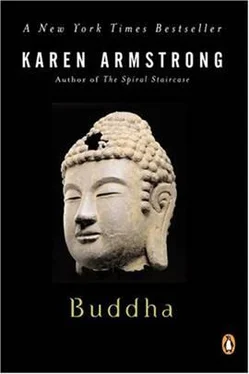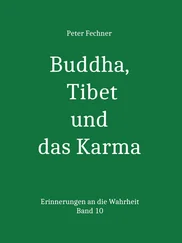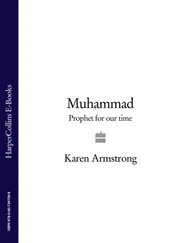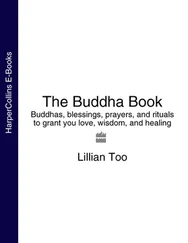But the full Dhamma was only possible for monks. The noise and bustle of the ordinary Indian household would make meditation and yoga impossibilities, so only a monk who had left this world could achieve Nibbana. A layman such as Anathapindika, who engaged in commercial and reproductive activities that were fueled by desire, could not hope to extinguish the three fires of greed, hatred and delusion. The best that a lay disciple could achieve was rebirth next time in circumstances that were more favorable to enlightenment. The Noble Truths were not for laymen; they had to be “realized” and this “direct” knowledge could not be achieved without yoga, which was essential to the full Buddhist regimen. Without the discipline of mindfulness, a doctrine such as anatta would make no sense. But the Buddha did not ignore the lay folk. It seems that there were two main lines of preaching: one for monks and another for the laity.
This becomes evident in the poignant story of Anathapindika’s death. When he became mortally ill, Sariputta and Ananda went to visit him, and Sariputta preached a short sermon on the value of detachment: Anathapindika should train himself not to cling to the senses, since this contact with the external world would trap him in samsara. This, one might think, was basic Buddhist teaching, but Anathapindika had never heard it before. As he listened, tears ran down his face. “What is the matter, householder?” Ananda asked anxiously. ‘Are you feeling worse?” No, Anathapindika protested; that was not the problem. It grieved him that “even though I have waited on the Master and the contemplative bhikkhus for so many years, I have never heard talk on the Dhamma like that before.” This teaching was not given to the lay people, Sariputta explained. It was only for those who had left the household life behind. That was not right, Anathapindika replied. Householders should be instructed in such matters: there were some with only a little desire in them, who were ripe for enlightenment and could, therefore, achieve Nibbana.
Anathapindika died that night and, we are told, was reborn in heaven as a “stream-enterer” with only seven more lives ahead of him. This was doubtless seen as a blessing, but it seems a poor reward for his generosity and devoted service. To keep such essential teaching from lay folk seems unfair, but the idea that everybody should be on the same spiritual footing is essentially modern. Premodern religion was nearly always conducted on two tiers, with an elite who spent their whole lives studying and meditating on scripture, and gave instruction to the inevitably more ignorant laity. Full religious equality only becomes a possibility when everybody is literate and has access to the scriptures. The Buddhist canon was not written down until the first century b.c.e., and even then manuscripts were rare. Anybody who wanted to hear the Dhamma would have to go to the Buddha or to one of the monks.
What did the Sangha preach to the laity? Lay people had “taken refuge” with the Buddha from the very first. Lay men and women would feed the monks and support them, acquiring merit that would get them good rebirths. The monks would also teach the laity how to live morally and perform good, purifying kamma that would advance their spiritual prospects. Everybody regarded this as a fair exchange. Some lay people, such as Anathapindika, would spend a lot of time with the Buddha and the bhikkhus. They were encouraged to take five moral vows-a Dhamma for beginners. They must not take life; they must not steal, lie or take intoxicants; they must avoid sexual promiscuity. These were much the same as the practices required of Jain lay disciples. On the quarter ( uposatha ) days of each month, the Buddhist laity had special disciplines to replace the fasting and abstinence of the old Vedic upavasatha, which, in practice, made them live like novices to the Sangha for twenty-four hours: they abstained from sex, did not watch entertainments, dressed soberly, and ate no solid food until midday. This gave them a taste of a fuller Buddhist life and might have inspired some to become monks.
Like any yogin, before the Buddhist monk could even begin to meditate, he had to undergo a moral training in compassion, self-control and mindfulness. The laity were never able to graduate to serious yoga, so they concentrated on this morality ( silo ) , which the Buddha adapted to their station of life. Laymen and -women were thus building the foundation for a fuller spirituality, which would stand them in good stead in their next existence. Where monks learned “skillful” techniques in meditation, the lay person focused on “skillful” morality. Giving alms to a bhikkhu, telling the truth at all times and behaving kindly and justly toward others helped them to develop a more wholesome state of mind, and to mitigate, if not wholly stamp out, the fires of egotism. This morality also had a practical advantage: it could encourage others to behave toward them in a similar manner. As a result, besides accruing merit in their next lives, they were learning ways of being happier in this one.
The Dhamma was very appealing to merchants and bankers like Anathapindika who had no place in the Vedic system. The businessmen could appreciate the Buddha’s “skillful” ethics, because it was based on the principle of shrewd investment. It would yield a profitable return, in this existence and the next. Monks were trained to be mindful of their fleeting mental states; lay followers were directed to appanada (attentiveness) in their financial and social dealings. The Buddha told them to save for an emergency, look after their dependents, give alms to bhikkhus, avoid debt, make sure that they had enough money for the immediate needs of their families, and invest money carefully. They were to be thrifty, sensible and sober. In the Sigalavada Sutta, the most developed sermon on lay morality, Sigala was instructed to avoid alcohol, late nights, gambling, laziness and bad company. There is a lay version of the Fire Sermon, in which the disciple is urged to tend the three “good fires”: taking care of his dependents; caring for his wife, children and servants; and supporting the bhikkhus in all the different sanghas.
But, as always, the cardinal virtue was compassion. One day King Pasenedi and his wife had a discussion in which each admitted that nothing was dearer to them than their own selves. This was obviously not a view that the Buddha could share, but when the king told him about this conversation, the Buddha did not chide him, launch into a discussion of anatta, or preach a sermon on the Eightfold Path. Instead, as usual, he entered into Pasenedi’s viewpoint, and built on what was in his mind-not on what the Buddha thought should be there. He did not, therefore, tell the king that the self was a delusion, because without a life of regular yoga, he would not be able to “see” this. Instead, he told him to consider this: if he found that there was nothing dearer to him than himself, it must also be true that other people also cherished their “separate selves.” Therefore, the Buddha concluded, “a person who loves the self, should not harm the self of others.” He should follow what other traditions have called the Golden Rule: “Do not do unto others as you would not have done unto you.” Laymen could not extinguish their egotism entirely, but they could use their experience of selfishness to empathize with other people’s vulnerability. This would take them beyond the excesses of ego and introduce them to ahimsa.
We see the way the Buddha preached to lay people in his famous sermon to the Kalamans, a people who lived on the northernmost fringe of the Ganges basin and who had once run a tribal republic, but were now subject to Kosala. Gradually, they were being drawn into the new urban civilization and were finding the experience unsettling and undermining. When the Buddha passed through their town of Kesaputta, they sent a delegation to ask his advice. One ascetic, one teacher after another had descended upon them, they explained; but each monk and brahmin expounded his own doctrines and reviled everybody else’s. Not only did these dhammas contradict one another, they were also alien, coming as they did from the sophisticated mainstream culture. “Which of these teachers was right and which wrong?” they asked. The Buddha replied that he could see why the Kalamans were so confused. As always, he entered completely into their position. He did not add to their confusion by reeling off his own Dhamma, and giving them one more doctrine to contend with, but held an impromptu tutorial (reminiscent of the question-and-answer techniques of such other Axial sages as Socrates and Confucius) to help the Kalamans work things out for themselves. He started by telling them that one of the reasons for their bewilderment was that they were expecting other people to tell them the answer, but when they looked into their own hearts, they would find that in fact they knew what was right already.
Читать дальше












